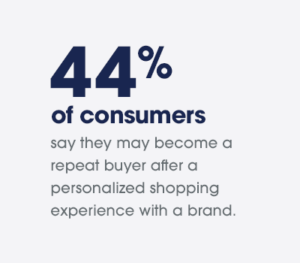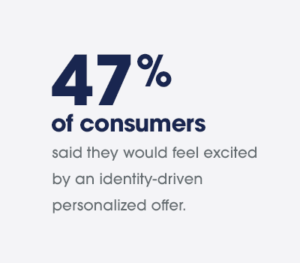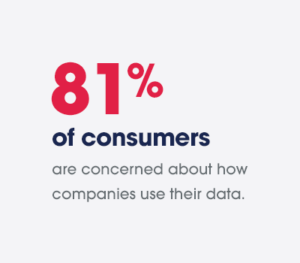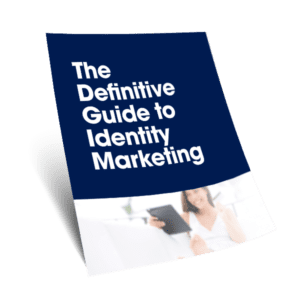What is Personalized Marketing?
Personalization in marketing is a strategy companies use to connect with customers on a one-to-one basis. There are two types of personalized marketing—push-based and pull-based.
With push-based marketing, companies collect and analyze data on customers—demographics, income levels, occupations, buying habits, and preferences—to create individualized content. Marketing automation delivers this content to customers through social media, email, blogs, and other means. While this approach can be easy to implement, prospects aren’t necessarily qualified, and their “intent to buy” signal is weak.
Pull-based marketing does not require brands to collect data before they send a message or create a promotion. Rather, they create a gated, personalized offer for a target group. The customer decides to opt-in by providing basic information that brands use to verify eligibility for the offer. Inviting customers to participate helps brands avoid many of the issues of traditional push-based marketing.
When successful, marketing personalization has many benefits. It builds customer trust and loyalty, converts prospects into customers, and encourages existing customers to spend more.
This article discusses what is personalization in marketing, including the benefits, examples of successful personalization strategies, the limits of current personalization strategies, and how a new form of personalization called identity marketing increases conversions and engagement.
Benefits of Personalized Marketing
With a well-planned, well-executed strategy, personalized marketing helps brands:
Increase Revenue
A personalized promotion that appeals to a prospect or customer’s likes, needs, and interests can increase conversions and engagement. Personalization also encourages impulse and repeat purchases. In fact, 44% of consumers say they may become a repeat buyer after a personalized shopping experience with a brand, and 25% say personalization “significantly influences” what they buy
The Starbucks Rewards program, which includes a highly interactive mobile app, helped increase revenue to $2.65 billion.

Delight Their Customers
Customers want something in return for the personal information they give to a brand. Personalization marketing lets brands deliver better, more relevant content that they can actually use. For example, personalized customer service makes it more convenient for customers to shop. OfficeMax uses location data to personalize its emails with a “buy now, pick up around the corner” strategy. The email includes a map and directions to their nearest OfficeMax.
Boost Brand Loyalty
Customers appreciate a brand that serves their needs by providing relevant content, a friendly face, and genuine customer service. Twiddy, a vacation rental company, observed trends and customer behavior to help homeowners calculate better pricing for rentals. The company increased their inventory by more than 10% while reducing costs by 15%.
Maintain Consistency Across All Channels
Ninety percent of retailers believe consistency across their brand’s engagement points affects customer loyalty, and 92% say it affects customers’ tendency to spend. Whether they shop in-store, in-app, or online, customers expect the brands to recognize who they are. Personalized communication based on purchasing history provides that recognition.
Increase Efficiency
Personalization accelerates the purchase process, making it easier for customers to buy again and again. Amazon’s one-click buy is a perfect example. According to Capgemini, more than 60% of shoppers are pleased when an online store remembers their personal and payment information to buy faster.

Deepen Customer Relationships
Customers crave authenticity in their brand relationships. They want to be recognized for who they are—their identity—not just another targeted segment: for example, “single mothers between the ages of 30 and 45 with an income of less than $50,000.”
Gated, personalized offers delivered to prospects based on their affiliation with a consumer tribe, such as teachers, military, and students, creates an emotional lift. Research shows that receiving an identity-driven offer would make nearly half of consumers (47%) feel excited, while 36% would feel special and 34% would feel honored.
Examples of Personalized Marketing
Personalization straddles all types of marketing to increase brand engagement with customers and prospects. Successful brands use personalization to:
Stand Out from the Crowd
Coca-Cola’s “Share a Coke” campaign, in which the brand printed popular names on Coke bottles, helped increase sales for the first time in 10 years. Customers were invited to share a Coke product with “Aimee,” “Chris,” “Zach,” and other friends.
Provide Relevant Recommendations
Amazon leads the way for delivering “contextually relevant” personalization. This includes customized onsite content based on a customer’s search and purchase history. Forty-four percent of customers buy from Amazon’s product recommendations, such as “frequently bought together” and “customers who bought this item also bought” prompts.
Go Where The Customers Are
In 2018, Nike launched a famous World Cup campaign across paid and owned media. Each content asset was optimized for different channels, so Nike was able to tell a sequential story no matter the touchpoint. Viewers could start watching on their mobile devices and continue the narrative on social media or other digital platforms.

Leverage the Power of Video
Cadbury’s integrated social video marketing campaign aimed to increase its share in the“chocolate-as-a-gift” marketing initiative in India. Givers could automatically create personalized videos with photos and names from their Facebook profile. Recipients could enjoy the video when they received their box of Cadbury Glow chocolate, either using a QR code or by providing their phone number on the Cadbury Glow page. The company achieved a 65% click-through-rate with recipients, and a 33% conversion rate for those who filled in a promotion form.
Create Tailored Email Campaigns
Spotify uses customer data such as music preferences to create personalized emails to increase in-app engagement. For example, users are kept up to date on new releases from favorite artists. Spotify also provides value beyond the company’s music streaming service. Every two weeks, customers receive email alerts of upcoming concerts near them. Personalized emails have 29% higher open rates and 41% higher click-through rates, according to Experian.
Challenges of Personalized Marketing
While some brands succeed with personalization, this strategy is in the Gartner Hype Cycle’s “trough of disillusionment.” Companies are struggling with implementations, best practices, and applications due to high costs and the difficulty of integrating data and systems.
The limits of push-based marketing highlight why brands are in this personalization slump. Push-based personalized marketing relies on traditional segmentation strategies, such as demographic segmentation, behavioral marketing, and customer data platforms—approaches that fall short in several important ways:
Incomplete, Low-Value Information
While easy and inexpensive, demographic segmentation provides only the most basic attributes on prospects, such as gender, age, and zip code. However, it doesn’t qualify prospects, and the intent signal to buy is weak, which in turn lowers the conversion rate.
High Cost
Customer data platforms (CDPs) use first-party data collection, which eases buyer worries about data privacy. A brand can confidently send personalized offers to existing customers. However, CDPs and related systems are expensive to set up and maintain, perhaps one reason customer acquisition costs have risen nearly 50% in the past five years. CDPs provide limited value, offering extensive information on customers but little to no information on prospects.
Limited Reach
With push-based marketing, members of a particular segment don’t know who else is in their group, so when they receive personalized marketing, it ends at their doorstep. For example, most customers at AT&T don’t know everyone else who uses the carrier. When these customers get a personalized offer, they can’t spread the word in a way that would help the brand.

Privacy Concerns
Behavioral marketing, which uses third-party data from Facebook and data management platforms (DMPs), offers greater insight than demographic segmentation. However, this information is unverified and relies on unethical data collection. Eighty-one percent of consumers are concerned about how companies use their data, and 79% of US adults use at least one tool to protect their online privacy and security.
Identity Marketing: A New Form of Personalization
Identity marketing—a new type of pull-based marketing—is transforming personalization. With identity marketing, brands deliver gated, personalized offers to consumer tribes, based on deep-seated attributes, such as their life stage (students, seniors), occupation (teachers), or affiliation (the military community).
Identity marketing campaigns boost customer acquisition by helping brands harness the networking power of consumer tribes to make an offer go viral. Unlike traditional segments, consumer tribes are socially connected, which greatly enhances sharing. For example:
- 83% of Gen Z would share a personalized offer with their friends.
- 96% of the military would share a personalized offer with others in the military community.
- 71% of teachers who receive a personalized offer would tell a colleague.
Here’s how identity marketing works:
- A company creates a personalized offer for a consumer tribe that aligns with its brand and invites prospects to take advantage of it through whatever channels the company normally uses.
- Consumers opt-in to redeem the offer and are digitally verified to ensure the offer’s integrity and prevent discount abuse.
- Brands use this zero-party data to nurture ongoing customer loyalty.
Identity marketing builds on three key pillars:
01 Personalization Is Rooted in Identity
Marketing to consumer tribes with identity-driven offers creates a strong emotional connection— something customers want. Research finds that 70% of emotionally engaged consumers spend up to 2x or more on their favorite brands, and 80% promote preferred brands to family and friends. So when brands are willing to align their brand identity with these groups and demonstrate they truly “see” consumers, people are motivated to act. Nearly 95% of consumers given a personalized offer based on their identity would redeem it.
02 Consent Creates a Reciprocal Exchange
Identity marketing is a form of “invited” personalization, where brands respect consumer privacy by meeting them on equal terms:
- A brand invites all members of the consumer tribe to enjoy a gated, personalized offer.
- Consumers choose to opt-in, “inviting” the brand into their lives.
- The brand and its new customers form a relationship built on mutual respect.
03 Verification Launches a Brand Relationship Built on Trust
To attract the correct audience, brands need to verify customers actually belong to the consumer tribe they’re targeting. Verification ensures the integrity of the offer in the eyes of the audience because they know the offer is truly exclusive. Verification also protects a company’s margins by preventing discount abuse, which can reach up to 30-35% for some brands.
Identity marketing further strengthens consumer trust by using third-party verification. Nearly three in five Americans would rather be verified for a gated, personalized offer by an independent third party than a brand’s customer service representative.
Verification also drives an emotional connection with consumers by creating a sense of communal belonging that motivates social sharing and word-of-mouth marketing. In this way, customers increase their social capital, and brands lower acquisition costs.
Identity Marketing Success Stories
Leading brands in retail, streaming, software, hospitality, and finance use identity marketing to acquire high-value consumer tribes:
Globus Reduced Discount Abuse by 35%
Travel brand Globus believed gated, personalized offers to the military would help them stand out, but worried about discount abuse. The company launched an identity marketing program to the military that:
Comcast Increases Conversions with Personalized Offer to Students
Streaming services giant Comcast created a bold offer that appealed to Gen Z: a steep discount for college students on plans that included free access to Amazon Music and HBO. “Our new gated student offer has taken off,” said Cheri Davies, senior director of acquisition marketing. The company saw “an enormous spike in traffic to its site and a significant lift in conversions.”
T-Mobile Uses Identity Marketing to Honor the Military
T-Mobile has become the go-to provider for the military by showing that it truly supports their community and is aligned with its values. The company not only offers the military a discount, it provides career support to veterans, contributes to military non-profits, and invests in infrastructure around military bases.
A Final Word on Personalized Marketing
Americans are exposed to an estimated 4,000 to 10,000 ads a day. Brands use personalized marketing to break through the noise and deliver meaningful content to their audience. Yet consumer trust is at an all-time low—half of Americans don’t trust the government or social media sites to protect their data. Customers want a new engagement model, where the cornerstone of personalization is built on trust.
Consumers also want authenticity; according to Forrester’s 2018 Consumer Experience Index, the way an experience makes customers feel has a bigger influence on brand loyalty than any other factor. To acquire and retain customers that are truly loyal, brands need to create a genuine and lasting emotional connection.
In this new marketplace, brands that harness the power of personalization will use methods like identity marketing that:
- Build trust with customers.
- Respect consumer privacy.
- Inspire word-of-mouth marketing.
Brands whose personalized marketing truly honors consumers will create genuine customer loyalty.



